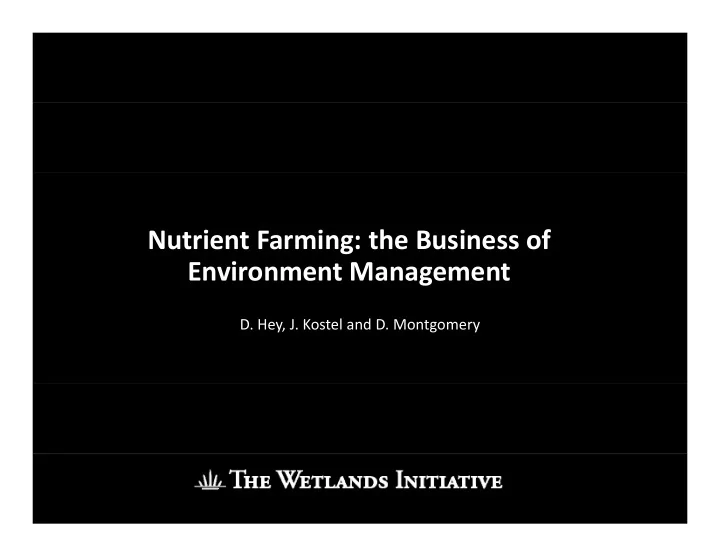

Nutrient Farming: the Business of Nutrient Farming: the Business of Environment Management D. Hey, J. Kostel and D. Montgomery
Problems to be solved: 1. water pollution 2. flood damage 3 3. erosion and sedimentation erosion and sedimentation 4. habitat destruction 5. global warming g g 6. waste heat 7. mercury methylation
• Land use controls the nature and disposition of topographic and structural changes to our floodplains and, as a result, it controls the detention and discharge of • Land use controls the nature and disposition of topographic and structural changes to our floodplains and, as a result, it controls the detention and discharge of • Land use controls the nature and disposition of topographic and structural changes to our floodplains and, as a result, it controls the detention and discharge of • Land use controls the nature and disposition of topographic and structural changes to our floodplains and, as a result, it controls the detention and discharge of • Land use controls the nature and disposition of topographic and structural changes to our floodplains and, as a result, it controls the detention and discharge of • Land use controls the nature and disposition of topographic and structural changes to our floodplains and, as a result, it controls the detention and discharge of • Land use controls the nature and disposition of topographic and structural changes to our floodplains and, as a result, it controls the detention and discharge of • Land use controls the nature and disposition of topographic and structural changes to our floodplains and, as a result, it controls the detention and discharge of • Land use controls the nature and disposition of topographic and structural changes to our floodplains and, as a result, it controls the detention and discharge of • Land use controls the nature and disposition of topographic and structural changes to our floodplains and, as a result, it controls the detention and discharge of • Land use controls the nature and disposition of topographic and structural changes to our floodplains and, as a result, it controls the detention and discharge of • Economics controls land use; therefore, • Economics controls land use; therefore, • Economics controls land use; therefore, • Economics controls land use; therefore, • Economics controls land use; therefore, • Economics controls land use; therefore, • Economics controls land use; therefore, • Economics controls land use; therefore, • Economics controls land use; therefore, • Economics controls land use; therefore, • Economics controls land use; therefore, • Economics controls flooding and flood damage. • Economics controls flooding and flood damage. • Economics controls flooding and flood damage. • Economics controls flooding and flood damage. • Economics controls flooding and flood damage. • Economics controls flooding and flood damage. • Economics controls flooding and flood damage. • Economics controls flooding and flood damage. • Economics controls flooding and flood damage. • Economics controls flooding and flood damage. • Economics controls flooding and flood damage. The environmental management syllogism 1. Land use controls the nature and distribution of development and its environmental impacts. p 2. Economics controls land use. 3. Therefore, economics controls air, land and water pollution. , , p
The solution corollary: The solution corollary: If economics controls our environmental problems, it can solve our problems!
If economics is to control, all development on the floodplain must bear the full cost of the development activity. • No governmental subsidies • No cost externalization
Externalizing the cost of floodplain development… Wetland Loss and Flood Damage Costs Compared to U.S. Army Corps of Engineers’ Expenditures Adjusted to 2006 using Construction Cost Index EM 1110 ‐ 2 ‐ 1304 Wetlands Drained Wetlands Drained Flood Control Expenditures (Accumulative) Flood Damages (Accumulative) Aggregate External Costs ( Expenditures + Damages) 120 $600 100 $500 f Dollars (2006) ons of Acres 80 $400 60 $300 Billions of Millio 40 $200 20 $100 0 $0 1928 1934 1940 1946 1952 1958 1964 1970 1976 1982 1988 1994 2000 2006 Fiscal Year …causes flood damages to grow
Externalizing the cost of farming… E t li i th t f f i 7 7 (Mg/L) 6 5 4 4 Nitrogen 3 1890s 2 1990 1990s 1 0 Oct ‐ Dec Jan ‐ Mar Apr ‐ Jun Jul ‐ Sept …nitrogen concentrations in the Illinois River have more than tripled in 100 years more than tripled in 100 years
Our Land Could be More Valuable Wet than Dry Potential Profit of Nutrient Farming $600 Recreation $500 Flood $400 $ Storage Carbon Carbon $300 Phosphorus Nutrient Nutrient Removal $200 Nitrogen $100 $100 $0 Nutrient Farming Corn Soybeans Nutrient and Other and Other $/Ac/Yr $/Ac/Yr Farming i Ecosystem Services
The Sue & Wes Dixon The Hennepin Drainage and Waterfowl Refuge Waterfowl Refuge Levee District which became Levee District, which became… Lost habitat Restored habitat
The potential annual market for ecosystem services produced by 5 million acres of restored 5 million acres of restored floodplain could exceed $2 billion dollars
wwwwetlands-initiative org www.wetlands initiative.org If you have any questions related to this presentation, please contact us at (312) 922-0777 or at p ( ) twi@wetlands-initiative. org
Recommend
More recommend